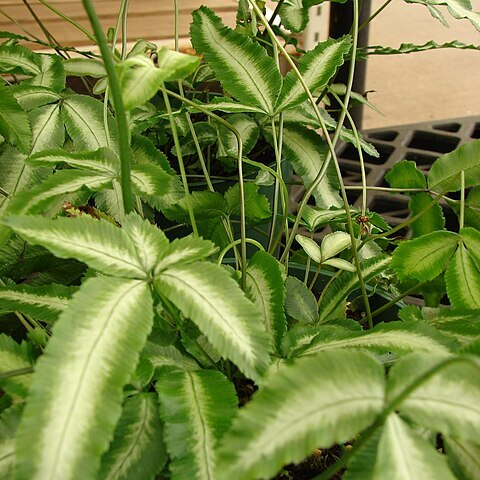Plants 30-50 cm tall. Rhizome ascending or prostrate, slender, 4-5 mm in diam., apex with black-brown scales. Fronds dense, dimorphic; sterile fronds 1.5-2(-3) cm apart, shorter than fertile fronds; stipe and rachis straw-colored, slightly lustrous, stipe 10-30 cm (stipes of sterile fronds shorter), 1.5-2 mm in diam., glabrescent; lamina oblong-ovate, 10-25 × 5-15 cm, pinnate to bipinnate; pinnae 2-6 pairs, opposite, slightly decumbent, upper ones sessile, lower pairs shortly stalked; sterile fronds often pinnate, triangular in outline, 2.5-3.5(-8) × 1.5-2.5(-8) cm, acuminate; pinnules (1 or)2 or 3 pairs, opposite, contiguous, sessile, decumbent, oblong-oblanceolate to broadly lanceolate, basally decurrent and entire, upward and apices with acute teeth, apex obtuse; pinnae of fertile fronds distant (basal pairs 5-7 cm apart), 1-3-forked, middle fork longest, apical pinnae not decurrent at base, basal two pairs sometimes pinnate; pinnules 2 or 3(or 4) pairs, decumbent, narrowly linear, basally decurrent, margins entire except at apices, sterile parts with dense teeth, apically acuminate; midvein straw-colored, adaxially prominent; veins dense, often forked; lamina gray-green to brown-green, sometimes with nearly white bands along each side of midvein, herbaceous when dried, glabrous. n = 58.
More
Short slender terrestrial and lithophytic ferns. Rhizome short-creeping to suberect, scaly; scales narrowly triangular, brown. Fronds ± dimorphic. Stipe to 20 cm long, pale green; base scaly. Lamina with pinnae (apart from apical pinna) increasing in length from apex to base. Sterile lamina c. 20 cm long; lower pinnae pinnate or pinnatifid, to 16 cm long; ultimate segments oblong to ovate, c. 8–10 mm wide, irregularly serrate. Fertile lamina to c. 30 cm long, narrower than sterile; pinnae forked near their base; ultimate segments linear to narrowly oblong, serrate only at their apices. Veins free, oblique, once-to twice-forked. Sori continuous from near base to near apices of fertile pinnae or pinnules; paraphyses scarce.
A compact fern. It grows 20-30 cm high and spreads 20-30 cm wide. It has a short creeping rhizome. The fronds are triangle shaped. They are of different lengths. They can be 15-30 cm long. The leaflets at the end are compound with 4-5 pairs of side leaflets cut into 2-6 oval lobes with teeth. Fertile fronds are one and a half times as long as sterile fronds. Some varieties have white or silver markings.

